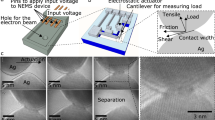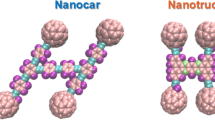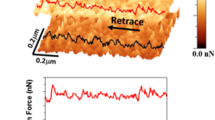Abstract
Understanding the relative motion of objects in contact is essential for controlling macroscopic lubrication and adhesion, for comprehending biological macromolecular interfaces, and for developing submicrometre-scale electromechanical devices1,2. An object undergoing lateral motion while in contact with a second object can either roll or slide. The resulting energy loss and mechanical wear depend largely on which mode of motion occurs. At the macroscopic scale, rolling3 is preferred over sliding, and it is expected to have an equally important role in the microscopic domain. Although progress has been made in our understanding of the dynamics of sliding at the atomic level4, we have no comparable insight into rolling owing to a lack of experimental data on microscopic length scales. Here we produce controlled rolling of carbon nanotubes on graphite surfaces using an atomic force microscope. We measure the accompanying energy loss and compare this with sliding. Moreover, by reproducibly rolling a nanotube to expose different faces to the substrate and to an external probe, we are able to study the object over its complete surface.
This is a preview of subscription content, access via your institution
Access options
Subscribe to this journal
Receive 51 print issues and online access
$199.00 per year
only $3.90 per issue
Buy this article
- Purchase on Springer Link
- Instant access to full article PDF
Prices may be subject to local taxes which are calculated during checkout


Similar content being viewed by others
References
Persson, B. N. J. Sliding Friction: Physical Properties and Applications(Springer, Berlin, (1998)).
Bhushan, B., Israelachvili, J. N. & Landman, U. Nanotribology: friction, wear and lubrication at the atomic scale. Nature 374, 607–616 (1995).
Johnson, K. L. Contact Mechanics(Cambridge University Press, New York, (1994)).
Mate, M. C., McClelland, G. M., Erlandsson, R. & Chiang, S. Atomic-scale friction of a tungsten tip on a graphite surface. Phys. Rev. Lett. 59, 1942–1945 (1987).
Israelachvili, J. Intermolecular and Surface Forces(Academic, San Diego, (1991)).
Binnig, G., Quate, C. F. & Gerbre, C. Atomic force microscope. Phys. Rev. Lett. 56, 930–933 (1986).
Sheehan, P. E. & Lieber, C. M. Nanotribology and nanofabrication of MoO3structures by atomic force microscopy. Science 272, 1158–1161 (1996).
Johnson, K. L. in Micro/nanotribology and its Applications(ed. Bhushan, B.) 157 (Kluwer Academic, Dordrecht, The Netherlands, (1997)).
Hirano, H., Shinjo, K., Kaneko, R. & Murata, Y. Anisotropy of frictional forces in muscovite mica. Phys. Rev. Lett. 67, 2642–2645 (1991).
Overney, R. M., Takano, H., Fujihira, M., Paulus, W. & Ringsdorf, H. Anisotropy in friction and molecular stick–slip motion. Phys. Rev. Lett. 72, 3546–3549 (1994).
Luthi, R. et al. Sled-type motion on the nanometer scale: Determination of dissipation and cohesive energies of C60. Science 266, 1979–1981 (1994).
Falvo, M. R. et al. Bending and buckling of carbon nanotubes under large strain. Nature 389, 582–584 (1997).
Hertel, T., Martel, R. & Avouris, P. Manipulation of individual carbon nanotubes and their interactions with surfaces. J. Phys. Chem. B 102, 910–915 (1998).
Rapoport, L. et al. Hollow nanoparticles of WS2 as potential solid-state lubricants. Nature 387, 791–793 (1997).
Bhushan, B., Gupta, B. K., Van Cleef, G. W., Capp, C. & Coe, J. V. Sublimed C60 films for tribology. Appl. Phys. Lett. 62, 3253–3255 (1993).
Schwarz, U. D., Zworner, O., Koster, P. & Wiesendanger, R. Quantitative analysis of the frictional properties of solid materials at low loads. 1. Carbon compounds. Phys. Rev. B 56, 6987–6996 (1997).
Ebbesen, T. W. & Ajayan, P. M. Large-scale synthesis of carbon nanotubes. Nature 358, 220–222 (1992).
Taylor, R. M. et al. SIGGRAPH '93(ACM SIGGRAPH, New York, (1993)).
Finch, M. et al. ACM Symposium on Interactive 3D Graphics(ACM SIGGRAPH, Monterey, California, (1995)).
Prescott, J. Mechanics of Particles and Rigid Bodies(Longmans, Green and Co., London, (1936)).
Baur, C. et al. Robotic nanomanipulation with a scanning probe microscope in a networked computing environment. J. Vac. Sci. Tech. B 15, 1577–1580 (1997).
Mason, M. T. & Salisbury, J. K. J. Robot Hands and the Mechanics of Manipulation(MIT Press, Cambridge, Massachusetts, (1985)).
Ebbesen, T. W. & Takada, T. Topological and sp3 defect structures in nanotubes. Carbon 33, 973–978 (1995).
Kendall, K. Rolling friction and adhesion between smooth solids. Wear 33, 351–358 (1975).
Chaudhury, M. J., Weaver, T., Hui, C. Y. & Kramer, E. J. Adhesive contact of cylindrical lens and a flat sheet. J. Appl. Phys. 80, 30–37 (1996).
Acknowledgements
We thank O. Zhou for CNT soot material, S. Paulson for helping to solve sample-preparation problems, and the entire Nanomanipulator team. The NSF, the NIH, the Office of Naval Research, and Topometrix Inc. provided financial support for this work.
Author information
Authors and Affiliations
Corresponding author
Rights and permissions
About this article
Cite this article
Falvo, M., Taylor II, R., Helser, A. et al. Nanometre-scale rolling and sliding of carbon nanotubes. Nature 397, 236–238 (1999). https://doi.org/10.1038/16662
Received:
Accepted:
Issue Date:
DOI: https://doi.org/10.1038/16662
This article is cited by
-
A comprehensive review of the effects of various factors on the thermal conductivity and rheological characteristics of CNT nanofluids
Journal of Thermal Analysis and Calorimetry (2023)
-
Diamagnetically levitated nanopositioners with large-range and multiple degrees of freedom
Nature Communications (2022)
-
Quantizing Chaplygin Hamiltonizable nonholonomic systems
Scientific Reports (2022)
-
Regulating Rolling and Sliding of Carbon Nanotubes on Graphite Through Doping and Charging
Tribology Letters (2022)
-
Frictional shear stress of ZnO nanowires on natural and pyrolytic graphite substrates
Friction (2022)
Comments
By submitting a comment you agree to abide by our Terms and Community Guidelines. If you find something abusive or that does not comply with our terms or guidelines please flag it as inappropriate.



